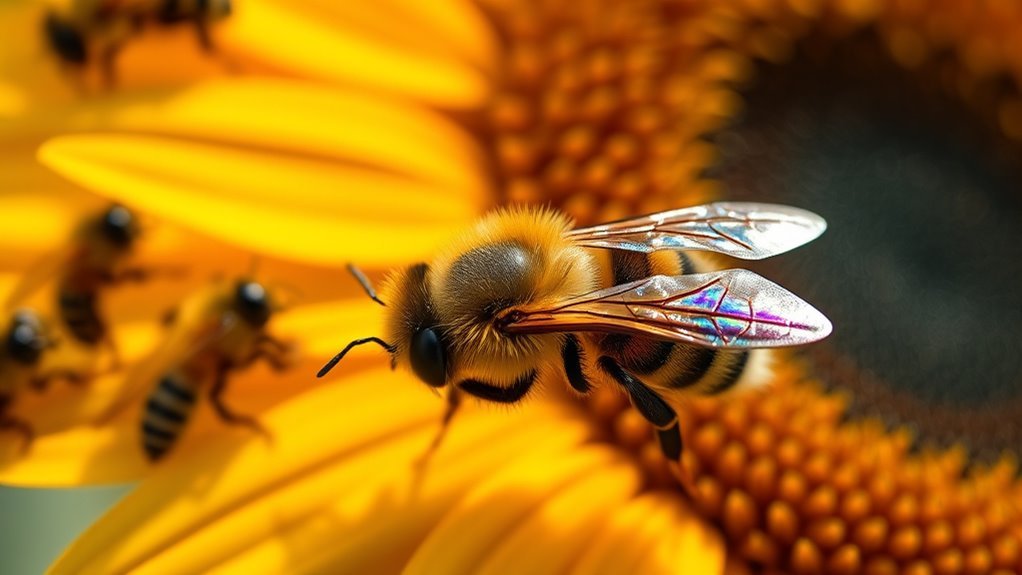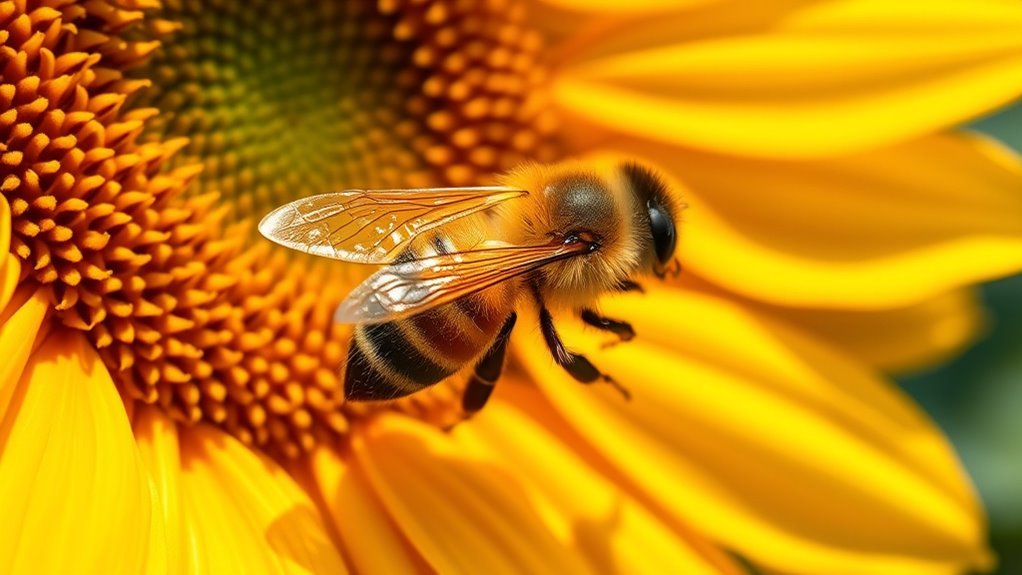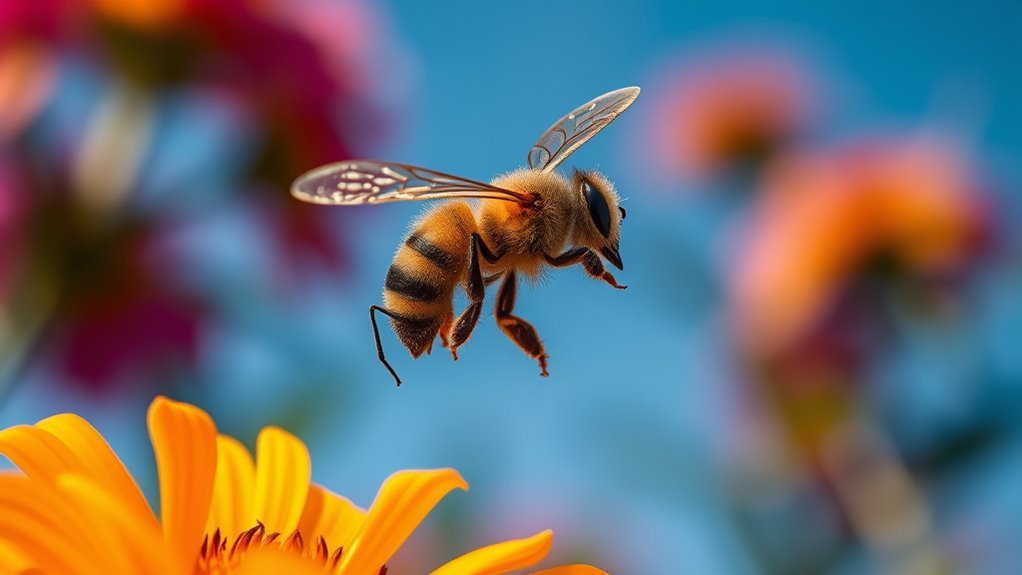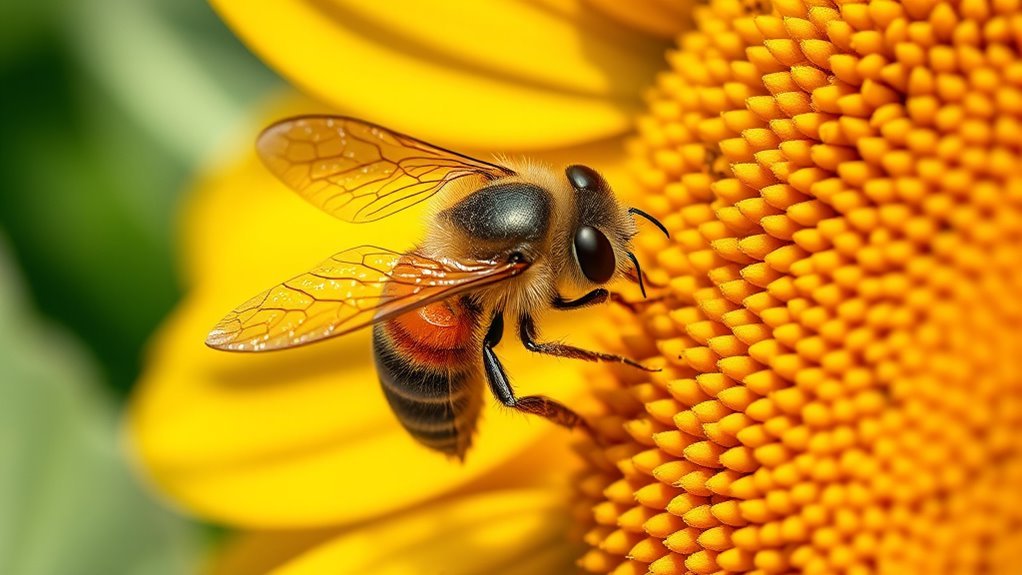A drone bee typically lives for about 8 weeks, but this can vary based on environmental factors like temperature and food availability. Drones are produced during spring and summer and play an essential role in mating with the queen. Their short lifespan is influenced by nutrition, hive health, and seasonal changes. After mating, many drones die shortly afterward, emphasizing their unique purpose. Exploring further, you’ll uncover more about their life cycle and significance in the hive.
The Life Cycle of Drone Bees

Although drone bees have a specific role within the hive, their life cycle is quite distinct from that of worker bees and the queen. Drones typically emerge from fertilized eggs, developing through stages of larva and pupa over about 14 days. Unlike workers, drones don’t gather food or care for the hive; their primary purpose revolves around mating rituals. During the summer months, drone behavior shifts as they congregate in drone congregation areas, where they perform aerial displays to attract queens. This mating occurs during a short window, after which the drones die shortly after copulation, having fulfilled their genetic duty. This brief yet intense existence underscores the unique biological imperative driving their life cycle, contrasting sharply with the more prolonged lives of workers and queens.
The Role of Drone Bees in the Hive

While drone bees may seem less essential compared to worker bees and the queen, their role in the hive is critical for the colony’s reproductive success. Drone bee behavior is primarily focused on mating, as they provide genetic diversity to the hive. This genetic exchange enhances hive dynamics, ensuring a healthier colony.
| Aspect | Drone Bees | Worker Bees |
|---|---|---|
| Primary Role | Mating with the queen | Foraging, hive maintenance |
| Lifespan | Short-lived during summer | Several weeks to months |
| Contribution | Genetic diversity | Food production and care |
| Behavior Pattern | Mating flights | Task-oriented within the hive |
Understanding these roles helps you appreciate how each member contributes to the hive’s overall sustainability.
Average Lifespan of Drone Bees

When considering the average lifespan of drone bees, you’ll find it’s typically around eight weeks, though various factors can influence this duration. Environmental conditions, availability of resources, and the overall health of the hive play significant roles in their longevity. In contrast to worker bees, which can live several months, the lifespan of drone bees highlights their specific reproductive function within the colony.
Lifespan Overview
Drone bees, which are male honeybees, typically have a lifespan of about 8 weeks, although this can vary based on environmental conditions and the specific needs of the hive. Understanding the average lifespan of drone bees helps you appreciate their role in hive dynamics and drone behavior. Here are some key points to reflect on:
- Drones are produced mainly during the spring and summer months.
- Their primary purpose is to mate with a queen, thereby contributing to genetic diversity.
- After mating, drones often die shortly due to their physical exertion.
- In the fall, drones are expelled from the hive, as they no longer serve a purpose.
- Their short lifespan highlights the efficiency of hive resource management.
This knowledge provides insight into the natural balance within bee colonies.
Factors Affecting Longevity
Several factors influence the longevity of drone bees, ultimately determining how long they can contribute to the hive. Nutrition sources play an important role; drones that receive diverse and high-quality pollen and nectar tend to live longer. These nutrient-rich resources bolster their immune systems and overall well-being. In addition, environmental impacts, such as temperature fluctuations and habitat availability, greatly affect their lifespan. In harsh conditions, including extreme heat or cold, drones may experience increased stress, which can shorten their lives. Moreover, the presence of predators or diseases in their environment can also diminish their longevity. By understanding these influences, you can appreciate the delicate balance that affects drone bees’ survival and their essential role in the hive’s ecosystem.
Comparison With Worker Bees
Although both drone bees and worker bees play crucial roles in the hive, their lifespans differ markedly. In a drone bee comparison, you’ll find that drones typically live about 8 weeks, while worker bees can survive several months. Here are some key worker bee differences that affect their longevity:
- Roles: Drones exist solely for mating, while workers engage in various tasks.
- Nutritional Intake: Worker bees consume more varied diets, enhancing their stamina.
- Development Stage: Worker bees emerge from fertilized eggs, while drones develop from unfertilized ones.
- Colony Dynamics: Drones are often expelled in winter, while workers remain.
- Reproductive Limits: After mating, drones die immediately, limiting their lifespan.
Understanding these distinctions helps clarify the unique life cycles within the hive.
Factors Affecting Drone Bee Longevity
While many factors come into play, the longevity of drone bees is primarily influenced by environmental conditions, genetics, and their role within the hive. Breeding conditions greatly impact their development; ideal nutrition and climate foster healthier drones with longer lifespans. Conversely, environmental stressors—such as extreme temperatures, pollution, and habitat loss—can lead to shorter life spans. Genetic diversity also plays an important role; drones that come from a more varied gene pool tend to exhibit greater resilience and adaptability. Within the hive, drones exist primarily for reproduction, and their lifespan is often cut short after mating. This multifaceted interplay of factors ultimately dictates how long drone bees can thrive and contribute to their colonies.
Seasonal Variations in Drone Bee Lifespan
When observing drone bee lifespans, you’ll notice significant seasonal variations that impact their longevity. During summer, drones thrive in a resource-rich environment, potentially living several weeks, while winter presents survival challenges that drastically shorten their lifespan. Understanding these dynamics is essential for comprehending the overall health and productivity of bee populations.
Summer Lifespan Dynamics
As summer unfolds, the lifespan of drone bees is greatly influenced by environmental factors and colony dynamics. During this season, you’ll notice distinct summer behaviors that impact how long these bees live. Several key influences shape their lifespan:
- Temperature fluctuations: Extreme heat can reduce activity and lifespan.
- Foraging opportunities: Abundant flowers lead to increased energy expenditure.
- Colony health: A thriving colony supports the drones better.
- Predation risks: Higher predator activity can shorten their lives.
- Mating pressures: As the season progresses, competition for mates intensifies.
Understanding these dynamics helps you appreciate how external conditions and internal colony functions intertwine to shape the lives of drone bees throughout summer.
Winter Survival Challenges
Although drone bees are typically produced in abundance during the warmer months, their survival through winter presents significant challenges that can dramatically affect their lifespan. The environmental challenges during this season include extreme cold, food scarcity, and the physiological stress of overwintering. Drone bees, unlike worker bees, don’t partake in hive duties during winter, making their survival reliant on the colony’s resources. Consequently, many drones perish before spring returns.
| Challenge | Impact on Drones | Survival Strategies |
|---|---|---|
| Extreme Cold | Shortened lifespan | Cluster for warmth |
| Food Scarcity | Starvation | Rely on hive stores |
| Physiological Stress | Reduced vigor | Minimize energy expenditure |
| Predation | Increased mortality | Stay within hive |
Understanding these factors is essential for anyone passionate about bee conservation.
The Mating Process of Drone Bees
How do drone bees guarantee the continuity of their genetic lineage? Through intricate mating rituals, drone bees engage in a process that assures the survival of their species. When the time comes, they’re selected based on specific traits that enhance genetic diversity. Here’s how it unfolds:
Drone bees engage in intricate mating rituals to ensure genetic diversity and the survival of their species.
- Drones gather in designated mating areas, called drone congregation areas.
- The queen bee flies to these areas, attracting drones with pheromones.
- Drones compete for the queen’s attention, showcasing their vigor.
- Successful drones mate mid-air, transferring sperm to the queen.
- Post-mating, drones typically die, fulfilling their role in reproduction.
This selective mating process not only promotes genetic strength but also influences the overall health of the hive.
The Fate of Drone Bees After Mating
After successfully mating with a queen, a drone bee’s life takes a dramatic turn. This moment marks the culmination of its mating behavior and reproductive role, but it comes at a significant cost. During mating, the drone’s reproductive organs are detached, leading to its inevitable demise shortly afterward. This self-sacrificial act guarantees the continuation of the hive’s genetic lineage but leaves the drone with a fleeting existence. Once mating occurs, the drone’s role shifts from potential mate to a mere vessel of reproduction, and it no longer contributes to the hive’s daily activities. Ultimately, this cycle highlights the stark reality of drone bees: their lives are intrinsically linked to a singular purpose, often leading to a brief and unceremonious end.
Importance of Drone Bees in Bee Populations
While many may overlook their significance due to their brief lifespan, drone bees play an important role in maintaining the genetic diversity and health of bee populations. Their reproductive roles are crucial for the survival of the hive, guaranteeing that the queen can mate with multiple drones, thereby increasing genetic variability. Consider the following drone bee significance:
Drone bees, despite their short lives, are vital for genetic diversity and the health of bee populations.
- Enhanced genetic diversity within the colony.
- Improved resilience to environmental changes and diseases.
- Strengthened overall hive productivity and efficiency.
- Promotion of hybrid vigor in future generations.
- Facilitation of successful mating flights, which guarantees queen fertility.
Recognizing these contributions helps you appreciate how drone bees, despite their short lives, are indispensable in sustaining healthy bee populations and ecosystems.
Frequently Asked Questions
Do Drone Bees Have Any Natural Predators?
Drone bees face several natural predators, including birds and wasps. Hive protection is essential, as worker bees fiercely defend against these threats, ensuring the drone population survives to fulfill their reproductive role during the season.
How Do Drone Bees Communicate With the Hive?
You’d think drone bees don’t communicate much, but their behavior greatly influences hive dynamics. They signal through pheromones, vibrations, and even body movements, ensuring a cohesive operation within the hive, despite their seemingly passive role.
Can Drone Bees Survive Winter?
Drone bees can’t survive winter; they don’t hibernate. Instead, the colony reduces its population, employing winter survival strategies that focus on maintaining the queen and worker bees, ensuring the hive’s continuity through colder months.
What Do Drone Bees Eat?
Like a delicate artist painting with sweet nectar, drone bees rely on a rich diet of nectar sources. Their nutrition primarily comes from flowers, fueling their energy for mating and sustaining hive activities throughout the season.
How Many Drones Are Typically in a Hive?
In a typical hive population, you’ll find around 100 to 300 drone bees. Their primary roles include mating with queens and contributing to hive dynamics, though they don’t gather nectar or pollen like worker bees.

